ACC00724 Accounting for Managers: JB Hi-Fi Financial Ratio Analysis
VerifiedAdded on 2023/05/30
|10
|1996
|250
Report
AI Summary
This report provides a comprehensive financial analysis of JB Hi-Fi (JBH) from 2014 to 2018, utilizing data from the company's annual reports. Key financial ratios, including profitability, efficiency, liquidity, financial gearing, and investment ratios, are calculated and analyzed to assess the company's performance and financial health. The analysis reveals improvements in profitability between FY2014 and FY2016, followed by a decline in FY2016-FY2018, primarily due to the acquisition of 'The Good Guys.' Efficiency ratios indicate stable inventory turnover but a slight increase in debtor settlement periods. Liquidity ratios show a decreasing trend in the current ratio, particularly after the acquisition. Financial gearing ratios reflect increased debt levels in FY2017 due to acquisition funding, with subsequent improvements in FY2018. The report also compares cash flows from operating, investing, and financing activities for FY2017 and FY2018, highlighting the impact of the acquisition and related financing activities on the company's cash flow patterns. Overall, the report offers insights into JB Hi-Fi's financial performance and the impact of strategic decisions on its financial position.
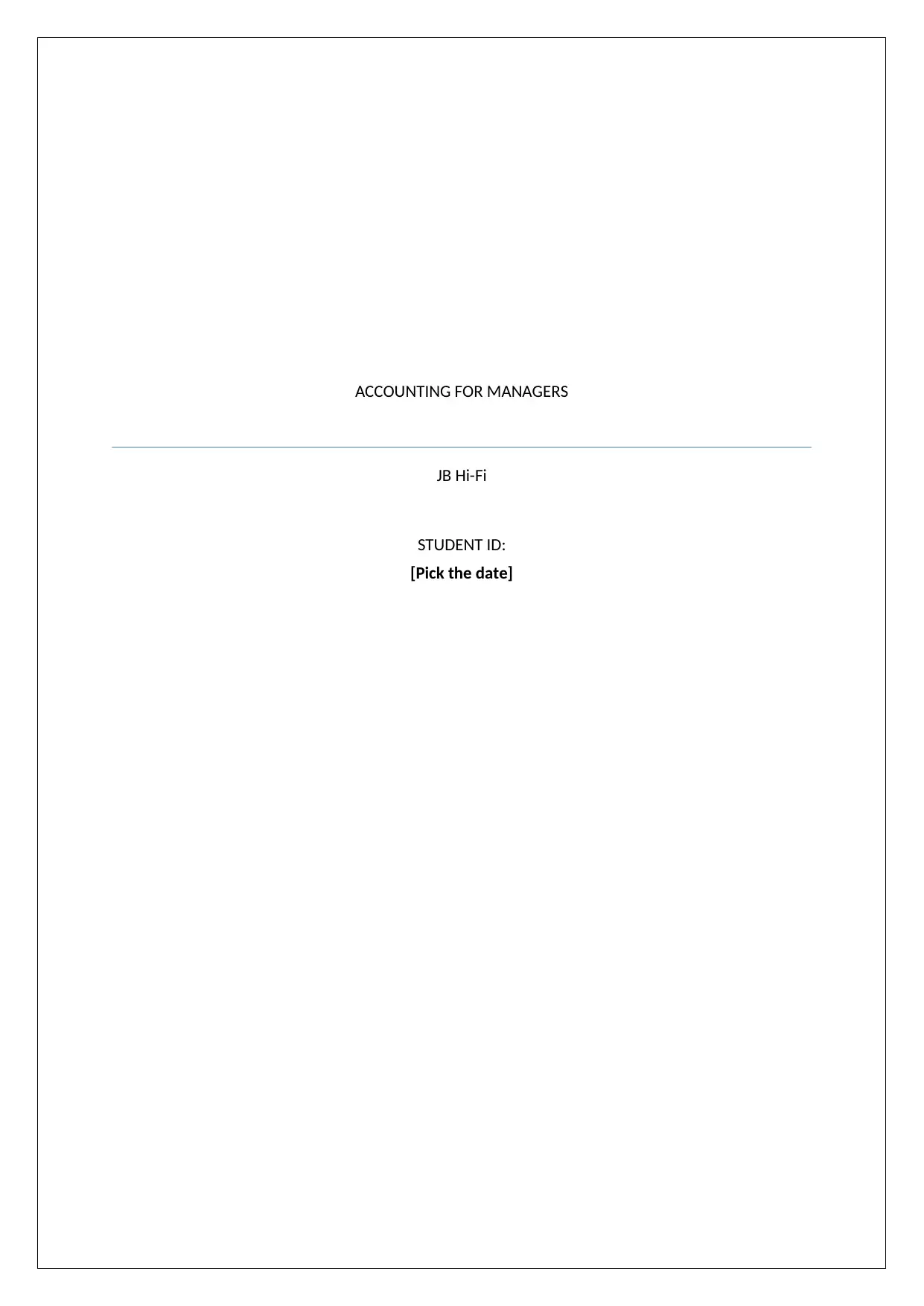
ACCOUNTING FOR MANAGERS
JB Hi-Fi
STUDENT ID:
[Pick the date]
JB Hi-Fi
STUDENT ID:
[Pick the date]
Paraphrase This Document
Need a fresh take? Get an instant paraphrase of this document with our AI Paraphraser
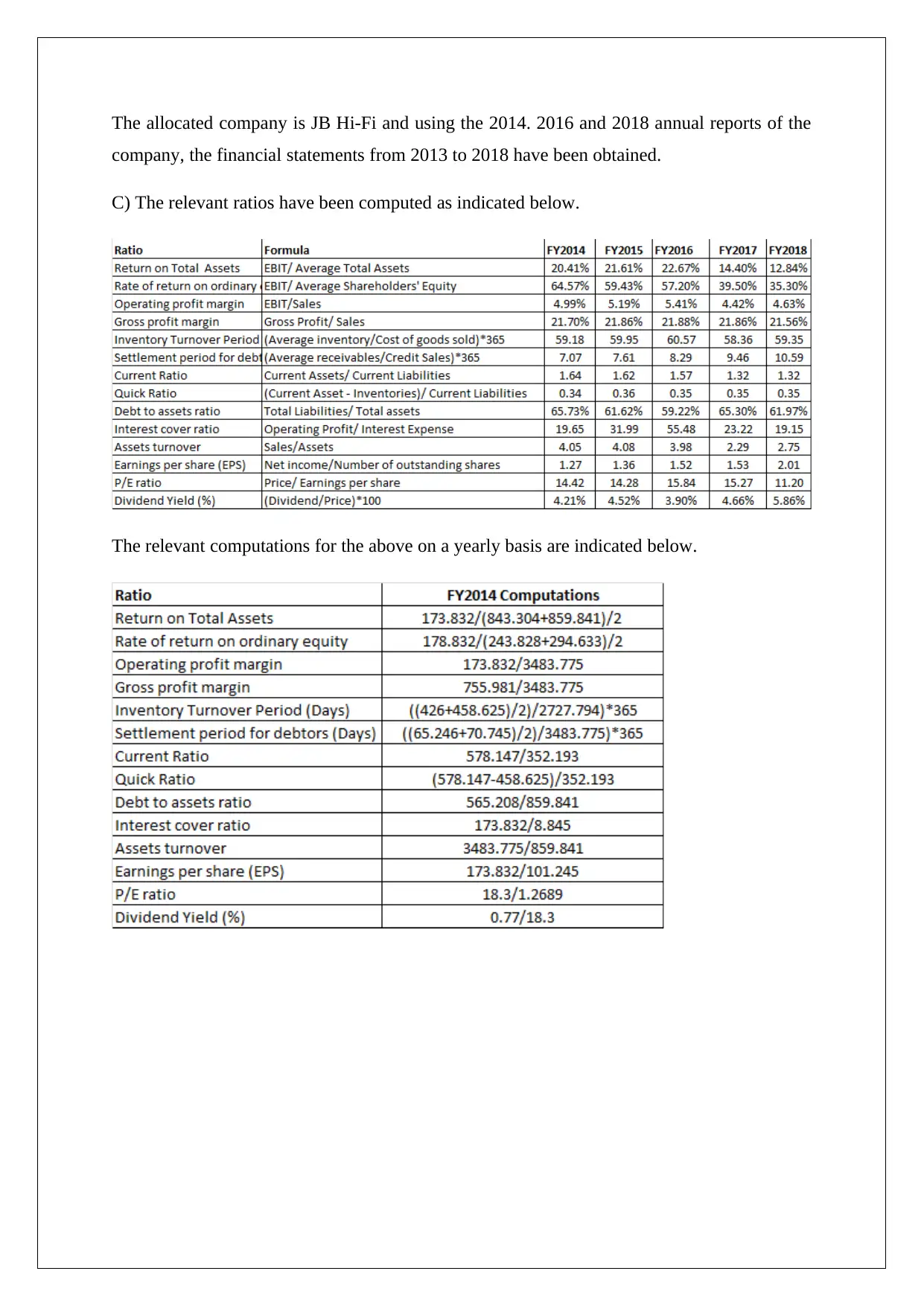
The allocated company is JB Hi-Fi and using the 2014. 2016 and 2018 annual reports of the
company, the financial statements from 2013 to 2018 have been obtained.
C) The relevant ratios have been computed as indicated below.
The relevant computations for the above on a yearly basis are indicated below.
company, the financial statements from 2013 to 2018 have been obtained.
C) The relevant ratios have been computed as indicated below.
The relevant computations for the above on a yearly basis are indicated below.
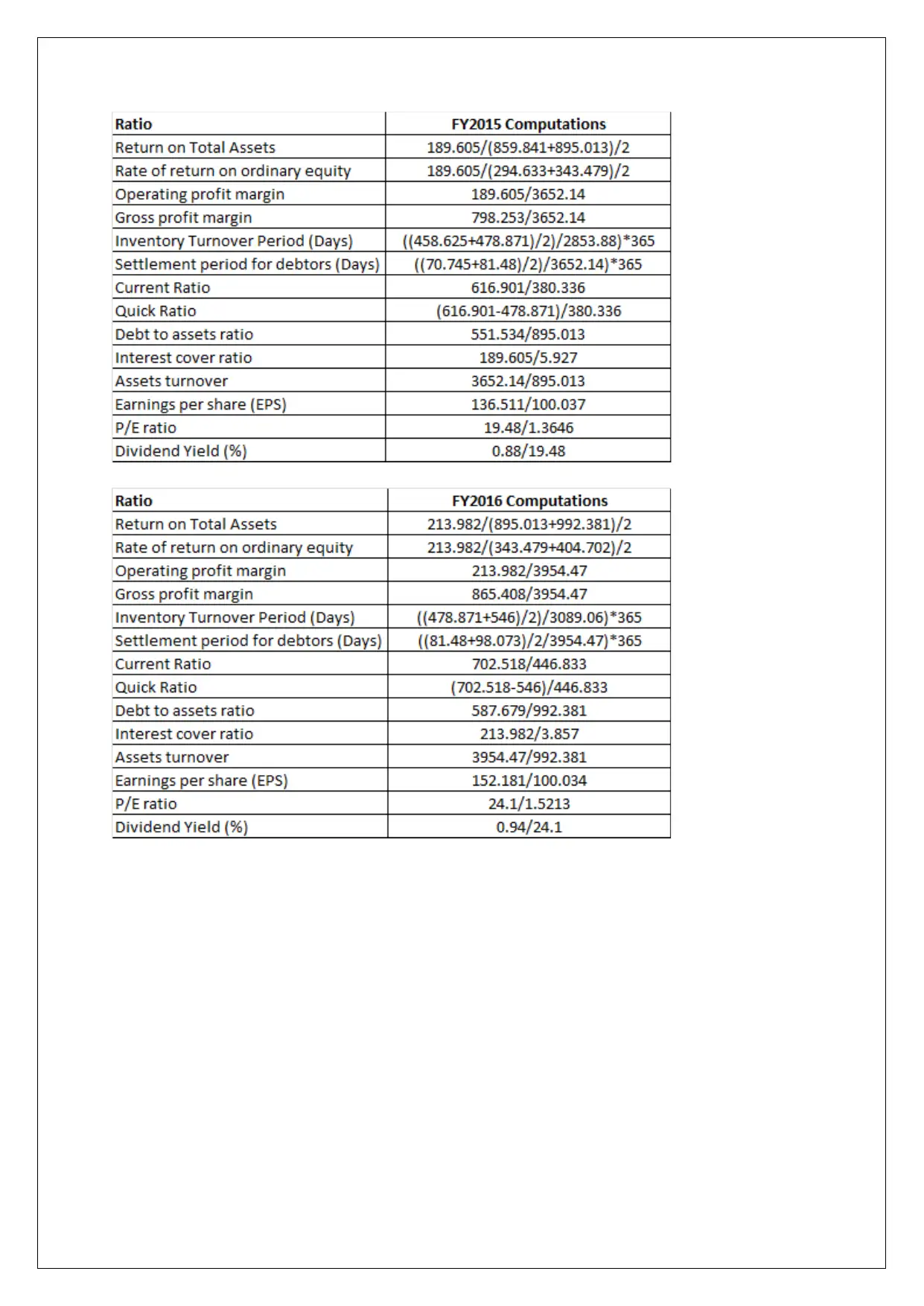
⊘ This is a preview!⊘
Do you want full access?
Subscribe today to unlock all pages.

Trusted by 1+ million students worldwide
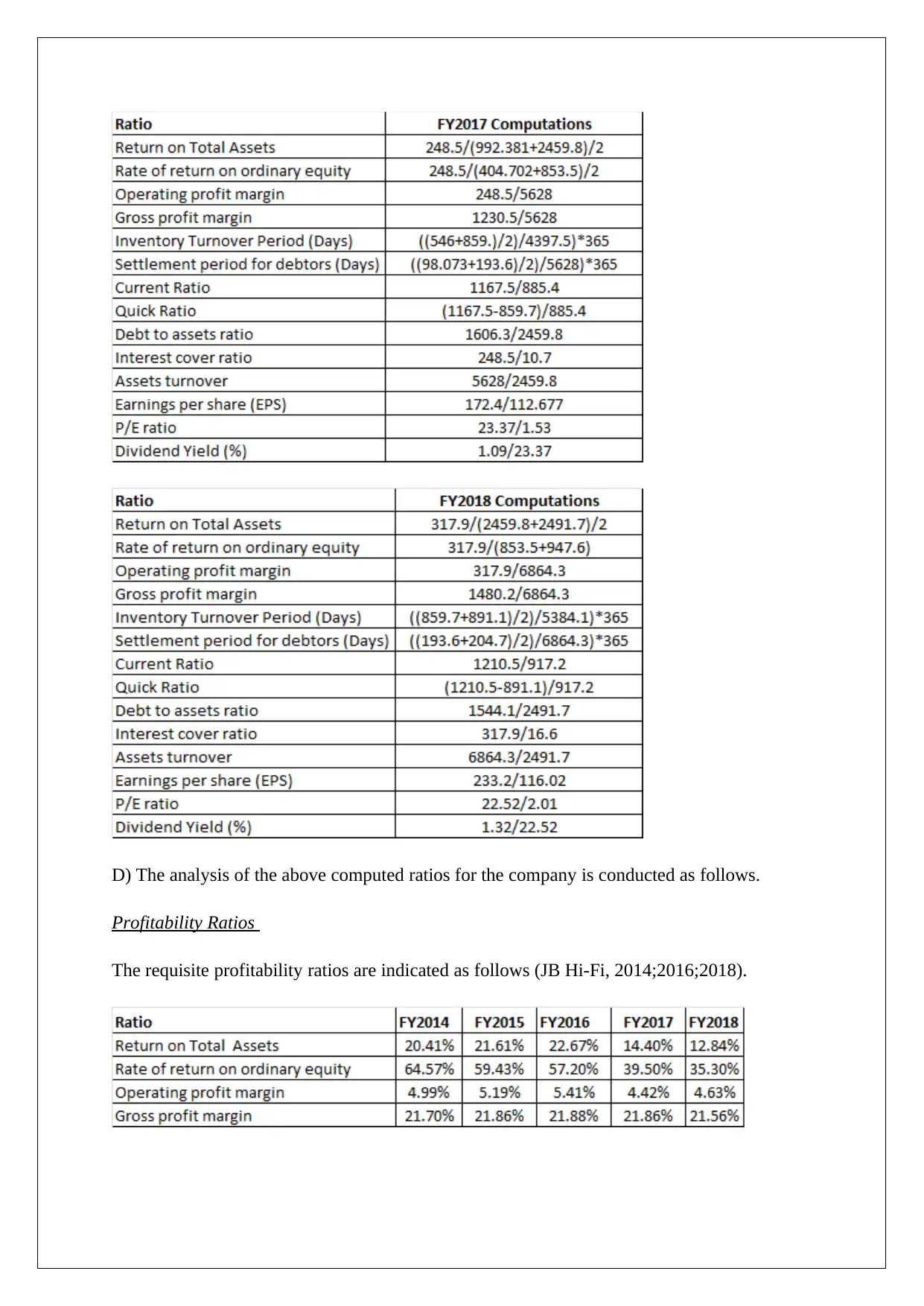
D) The analysis of the above computed ratios for the company is conducted as follows.
Profitability Ratios
The requisite profitability ratios are indicated as follows (JB Hi-Fi, 2014;2016;2018).
Profitability Ratios
The requisite profitability ratios are indicated as follows (JB Hi-Fi, 2014;2016;2018).
Paraphrase This Document
Need a fresh take? Get an instant paraphrase of this document with our AI Paraphraser
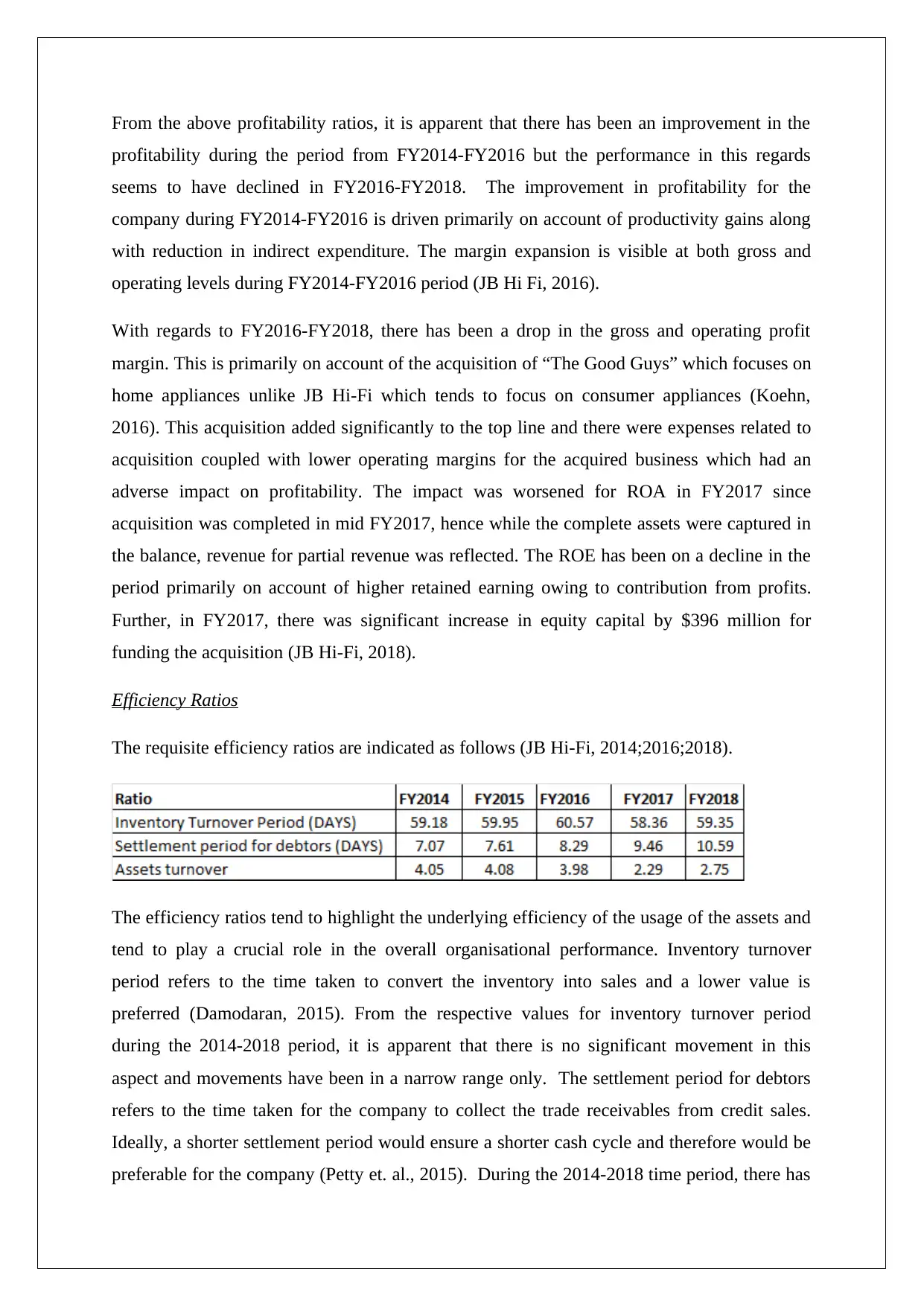
From the above profitability ratios, it is apparent that there has been an improvement in the
profitability during the period from FY2014-FY2016 but the performance in this regards
seems to have declined in FY2016-FY2018. The improvement in profitability for the
company during FY2014-FY2016 is driven primarily on account of productivity gains along
with reduction in indirect expenditure. The margin expansion is visible at both gross and
operating levels during FY2014-FY2016 period (JB Hi Fi, 2016).
With regards to FY2016-FY2018, there has been a drop in the gross and operating profit
margin. This is primarily on account of the acquisition of “The Good Guys” which focuses on
home appliances unlike JB Hi-Fi which tends to focus on consumer appliances (Koehn,
2016). This acquisition added significantly to the top line and there were expenses related to
acquisition coupled with lower operating margins for the acquired business which had an
adverse impact on profitability. The impact was worsened for ROA in FY2017 since
acquisition was completed in mid FY2017, hence while the complete assets were captured in
the balance, revenue for partial revenue was reflected. The ROE has been on a decline in the
period primarily on account of higher retained earning owing to contribution from profits.
Further, in FY2017, there was significant increase in equity capital by $396 million for
funding the acquisition (JB Hi-Fi, 2018).
Efficiency Ratios
The requisite efficiency ratios are indicated as follows (JB Hi-Fi, 2014;2016;2018).
The efficiency ratios tend to highlight the underlying efficiency of the usage of the assets and
tend to play a crucial role in the overall organisational performance. Inventory turnover
period refers to the time taken to convert the inventory into sales and a lower value is
preferred (Damodaran, 2015). From the respective values for inventory turnover period
during the 2014-2018 period, it is apparent that there is no significant movement in this
aspect and movements have been in a narrow range only. The settlement period for debtors
refers to the time taken for the company to collect the trade receivables from credit sales.
Ideally, a shorter settlement period would ensure a shorter cash cycle and therefore would be
preferable for the company (Petty et. al., 2015). During the 2014-2018 time period, there has
profitability during the period from FY2014-FY2016 but the performance in this regards
seems to have declined in FY2016-FY2018. The improvement in profitability for the
company during FY2014-FY2016 is driven primarily on account of productivity gains along
with reduction in indirect expenditure. The margin expansion is visible at both gross and
operating levels during FY2014-FY2016 period (JB Hi Fi, 2016).
With regards to FY2016-FY2018, there has been a drop in the gross and operating profit
margin. This is primarily on account of the acquisition of “The Good Guys” which focuses on
home appliances unlike JB Hi-Fi which tends to focus on consumer appliances (Koehn,
2016). This acquisition added significantly to the top line and there were expenses related to
acquisition coupled with lower operating margins for the acquired business which had an
adverse impact on profitability. The impact was worsened for ROA in FY2017 since
acquisition was completed in mid FY2017, hence while the complete assets were captured in
the balance, revenue for partial revenue was reflected. The ROE has been on a decline in the
period primarily on account of higher retained earning owing to contribution from profits.
Further, in FY2017, there was significant increase in equity capital by $396 million for
funding the acquisition (JB Hi-Fi, 2018).
Efficiency Ratios
The requisite efficiency ratios are indicated as follows (JB Hi-Fi, 2014;2016;2018).
The efficiency ratios tend to highlight the underlying efficiency of the usage of the assets and
tend to play a crucial role in the overall organisational performance. Inventory turnover
period refers to the time taken to convert the inventory into sales and a lower value is
preferred (Damodaran, 2015). From the respective values for inventory turnover period
during the 2014-2018 period, it is apparent that there is no significant movement in this
aspect and movements have been in a narrow range only. The settlement period for debtors
refers to the time taken for the company to collect the trade receivables from credit sales.
Ideally, a shorter settlement period would ensure a shorter cash cycle and therefore would be
preferable for the company (Petty et. al., 2015). During the 2014-2018 time period, there has
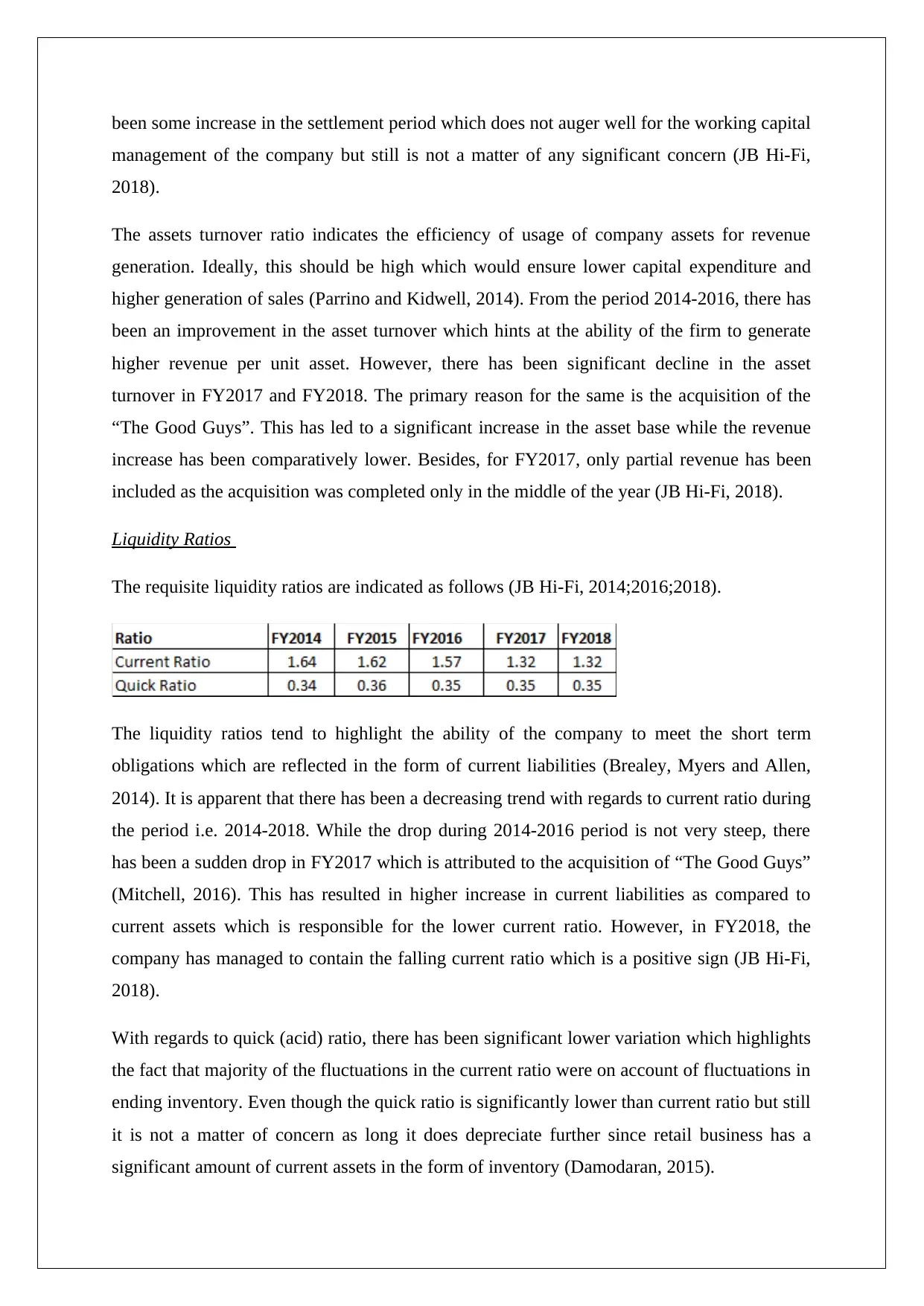
been some increase in the settlement period which does not auger well for the working capital
management of the company but still is not a matter of any significant concern (JB Hi-Fi,
2018).
The assets turnover ratio indicates the efficiency of usage of company assets for revenue
generation. Ideally, this should be high which would ensure lower capital expenditure and
higher generation of sales (Parrino and Kidwell, 2014). From the period 2014-2016, there has
been an improvement in the asset turnover which hints at the ability of the firm to generate
higher revenue per unit asset. However, there has been significant decline in the asset
turnover in FY2017 and FY2018. The primary reason for the same is the acquisition of the
“The Good Guys”. This has led to a significant increase in the asset base while the revenue
increase has been comparatively lower. Besides, for FY2017, only partial revenue has been
included as the acquisition was completed only in the middle of the year (JB Hi-Fi, 2018).
Liquidity Ratios
The requisite liquidity ratios are indicated as follows (JB Hi-Fi, 2014;2016;2018).
The liquidity ratios tend to highlight the ability of the company to meet the short term
obligations which are reflected in the form of current liabilities (Brealey, Myers and Allen,
2014). It is apparent that there has been a decreasing trend with regards to current ratio during
the period i.e. 2014-2018. While the drop during 2014-2016 period is not very steep, there
has been a sudden drop in FY2017 which is attributed to the acquisition of “The Good Guys”
(Mitchell, 2016). This has resulted in higher increase in current liabilities as compared to
current assets which is responsible for the lower current ratio. However, in FY2018, the
company has managed to contain the falling current ratio which is a positive sign (JB Hi-Fi,
2018).
With regards to quick (acid) ratio, there has been significant lower variation which highlights
the fact that majority of the fluctuations in the current ratio were on account of fluctuations in
ending inventory. Even though the quick ratio is significantly lower than current ratio but still
it is not a matter of concern as long it does depreciate further since retail business has a
significant amount of current assets in the form of inventory (Damodaran, 2015).
management of the company but still is not a matter of any significant concern (JB Hi-Fi,
2018).
The assets turnover ratio indicates the efficiency of usage of company assets for revenue
generation. Ideally, this should be high which would ensure lower capital expenditure and
higher generation of sales (Parrino and Kidwell, 2014). From the period 2014-2016, there has
been an improvement in the asset turnover which hints at the ability of the firm to generate
higher revenue per unit asset. However, there has been significant decline in the asset
turnover in FY2017 and FY2018. The primary reason for the same is the acquisition of the
“The Good Guys”. This has led to a significant increase in the asset base while the revenue
increase has been comparatively lower. Besides, for FY2017, only partial revenue has been
included as the acquisition was completed only in the middle of the year (JB Hi-Fi, 2018).
Liquidity Ratios
The requisite liquidity ratios are indicated as follows (JB Hi-Fi, 2014;2016;2018).
The liquidity ratios tend to highlight the ability of the company to meet the short term
obligations which are reflected in the form of current liabilities (Brealey, Myers and Allen,
2014). It is apparent that there has been a decreasing trend with regards to current ratio during
the period i.e. 2014-2018. While the drop during 2014-2016 period is not very steep, there
has been a sudden drop in FY2017 which is attributed to the acquisition of “The Good Guys”
(Mitchell, 2016). This has resulted in higher increase in current liabilities as compared to
current assets which is responsible for the lower current ratio. However, in FY2018, the
company has managed to contain the falling current ratio which is a positive sign (JB Hi-Fi,
2018).
With regards to quick (acid) ratio, there has been significant lower variation which highlights
the fact that majority of the fluctuations in the current ratio were on account of fluctuations in
ending inventory. Even though the quick ratio is significantly lower than current ratio but still
it is not a matter of concern as long it does depreciate further since retail business has a
significant amount of current assets in the form of inventory (Damodaran, 2015).
⊘ This is a preview!⊘
Do you want full access?
Subscribe today to unlock all pages.

Trusted by 1+ million students worldwide

Financial Gearing Ratios
The requisite financial gearing ratios are indicated as follows (JB Hi-Fi, 2014;2016;2018).
The financial gearing ratios highlight the ability of the company to meet the long term
obligations (Petty et. al., 2015). The debt to assets during 2014-2016 period has been on the
decline which is positive for the company and indicates at lower leveraging of the balance
sheet as the share of equity in funding has increased. However, there is a significant jump in
debt to assets ratio in FY2017 as the company had to assume a significant amount of debt for
funding the acquisition. However, a positive trend is that in FY2018, the ratio has again
declined which highlights the focus of the company to ensure that the balance sheet does not
become over leveraged. The company also raised significant equity in FY2017 for funding
the acquisition. The interest cover ratio has shown significant improvement during the 2014-
2016 period but post this period there has been a decline owing to higher interest expenses
which have surpassed the increase in operating profits (JB Hi-Fi, 2018). However, the interest
cover ratio of the company continues to be healthy and poses no significant risk of any
default (Parrino and Kidwell, 2014).
Investment Ratios
The requisite investment ratios are indicated as follows (JB Hi-Fi, 2014;2016;2018).
There is an increase in EPS for the company during the 2014-2018 time interval. It is
noticeable that increase is particularly significant in FY2018 as it is first year which includes
the complete years results of the acquired business of the “The Good Guys”. However, it is
noticeable that P/E ratio of the company has not expanded over the last five years but has
contracted which represents a significant opportunity to invest in the company. Further, the
dividend yield on the stock of the company is quite impressive considering the fact that it has
remaining around 4%-6% during the entire period.
The requisite financial gearing ratios are indicated as follows (JB Hi-Fi, 2014;2016;2018).
The financial gearing ratios highlight the ability of the company to meet the long term
obligations (Petty et. al., 2015). The debt to assets during 2014-2016 period has been on the
decline which is positive for the company and indicates at lower leveraging of the balance
sheet as the share of equity in funding has increased. However, there is a significant jump in
debt to assets ratio in FY2017 as the company had to assume a significant amount of debt for
funding the acquisition. However, a positive trend is that in FY2018, the ratio has again
declined which highlights the focus of the company to ensure that the balance sheet does not
become over leveraged. The company also raised significant equity in FY2017 for funding
the acquisition. The interest cover ratio has shown significant improvement during the 2014-
2016 period but post this period there has been a decline owing to higher interest expenses
which have surpassed the increase in operating profits (JB Hi-Fi, 2018). However, the interest
cover ratio of the company continues to be healthy and poses no significant risk of any
default (Parrino and Kidwell, 2014).
Investment Ratios
The requisite investment ratios are indicated as follows (JB Hi-Fi, 2014;2016;2018).
There is an increase in EPS for the company during the 2014-2018 time interval. It is
noticeable that increase is particularly significant in FY2018 as it is first year which includes
the complete years results of the acquired business of the “The Good Guys”. However, it is
noticeable that P/E ratio of the company has not expanded over the last five years but has
contracted which represents a significant opportunity to invest in the company. Further, the
dividend yield on the stock of the company is quite impressive considering the fact that it has
remaining around 4%-6% during the entire period.
Paraphrase This Document
Need a fresh take? Get an instant paraphrase of this document with our AI Paraphraser

D) The statement of cash flow for FY2017 and FY2018 has been compared below
Cash flows from operating activities
The relevant comparison for FY2017 and FY2018 is indicated as follows (JB Hi-Fi, 2018).
It is apparent that in FY2018, there is a significant increase in the customer receipts by more
than 20% but the payment to suppliers has also increased by same amount. Owing to higher
debt taken for the acquisition, there is an increase in the payment of interest and related
finance costs. Further, there is a higher income tax related outflow in FY2018 in comparison
to the previous year. The operating cash flow changes are indicative of the reflection of the
complete year revenues of the acquired entity owing to which there is an increase both in the
top line as well as the underlying costs.
Cash Flows from Investing Activities
The relevant comparison for FY2017 and FY2018 is indicated as follows (JB Hi-Fi, 2018).
In FY2017, an acquisition was made by the company for which there was a total cash outflow
to the tune of $ 836.6 million while there was no acquisition in FY2018 and hence the cash
outflow in this regards was zero. Further, the company had some cash outflow for plant and
equipment and also cash inflow was received by the company on account of existing assets
related to plant and equipment. Clearly, the company barring the acquisition is not making
any significant capital expenditure related to business.
Cash Flows from Financing Activities
The relevant comparison for FY2017 and FY2018 is indicated as follows (JB Hi-Fi, 2018).
Cash flows from operating activities
The relevant comparison for FY2017 and FY2018 is indicated as follows (JB Hi-Fi, 2018).
It is apparent that in FY2018, there is a significant increase in the customer receipts by more
than 20% but the payment to suppliers has also increased by same amount. Owing to higher
debt taken for the acquisition, there is an increase in the payment of interest and related
finance costs. Further, there is a higher income tax related outflow in FY2018 in comparison
to the previous year. The operating cash flow changes are indicative of the reflection of the
complete year revenues of the acquired entity owing to which there is an increase both in the
top line as well as the underlying costs.
Cash Flows from Investing Activities
The relevant comparison for FY2017 and FY2018 is indicated as follows (JB Hi-Fi, 2018).
In FY2017, an acquisition was made by the company for which there was a total cash outflow
to the tune of $ 836.6 million while there was no acquisition in FY2018 and hence the cash
outflow in this regards was zero. Further, the company had some cash outflow for plant and
equipment and also cash inflow was received by the company on account of existing assets
related to plant and equipment. Clearly, the company barring the acquisition is not making
any significant capital expenditure related to business.
Cash Flows from Financing Activities
The relevant comparison for FY2017 and FY2018 is indicated as follows (JB Hi-Fi, 2018).
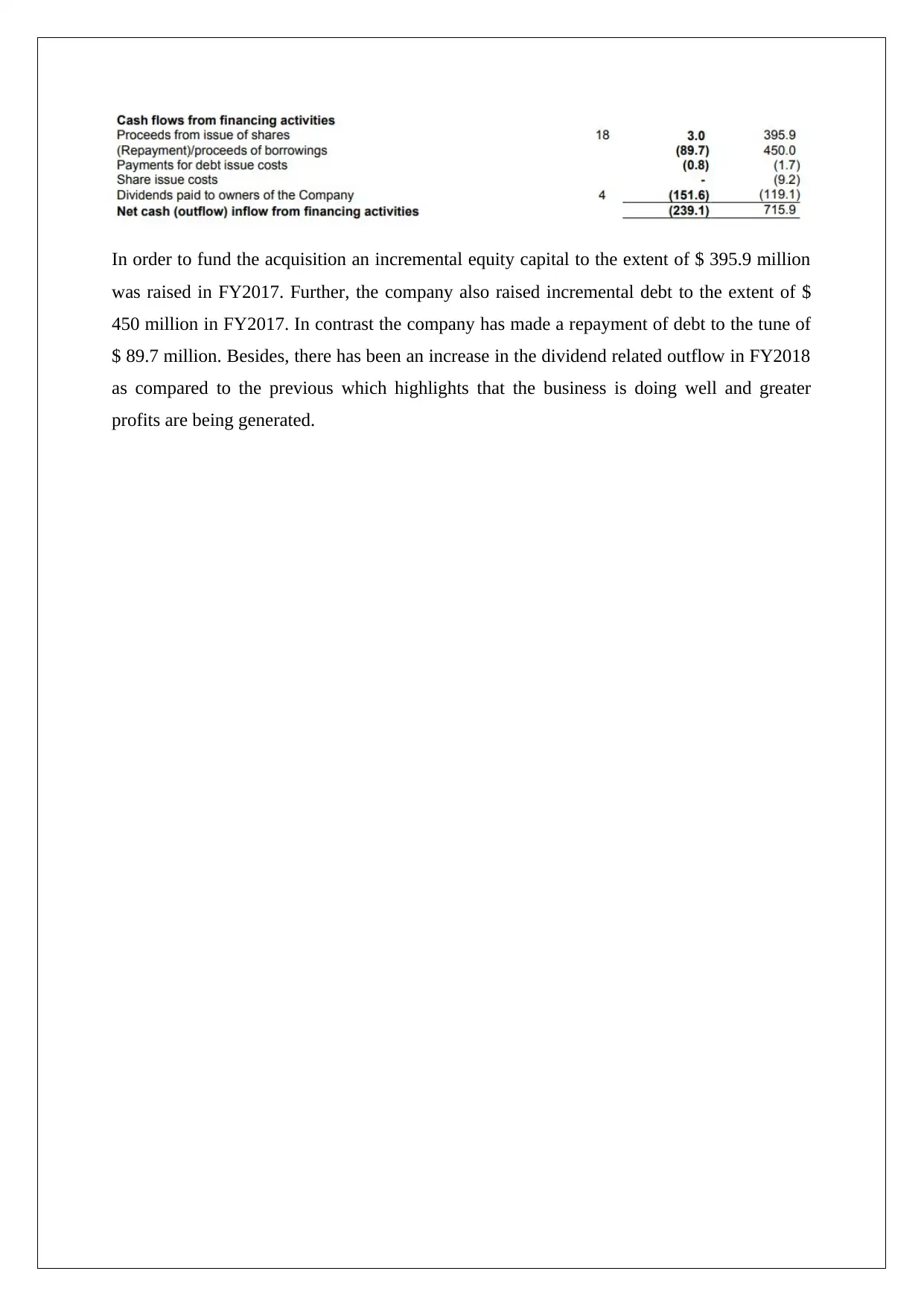
In order to fund the acquisition an incremental equity capital to the extent of $ 395.9 million
was raised in FY2017. Further, the company also raised incremental debt to the extent of $
450 million in FY2017. In contrast the company has made a repayment of debt to the tune of
$ 89.7 million. Besides, there has been an increase in the dividend related outflow in FY2018
as compared to the previous which highlights that the business is doing well and greater
profits are being generated.
was raised in FY2017. Further, the company also raised incremental debt to the extent of $
450 million in FY2017. In contrast the company has made a repayment of debt to the tune of
$ 89.7 million. Besides, there has been an increase in the dividend related outflow in FY2018
as compared to the previous which highlights that the business is doing well and greater
profits are being generated.
⊘ This is a preview!⊘
Do you want full access?
Subscribe today to unlock all pages.

Trusted by 1+ million students worldwide
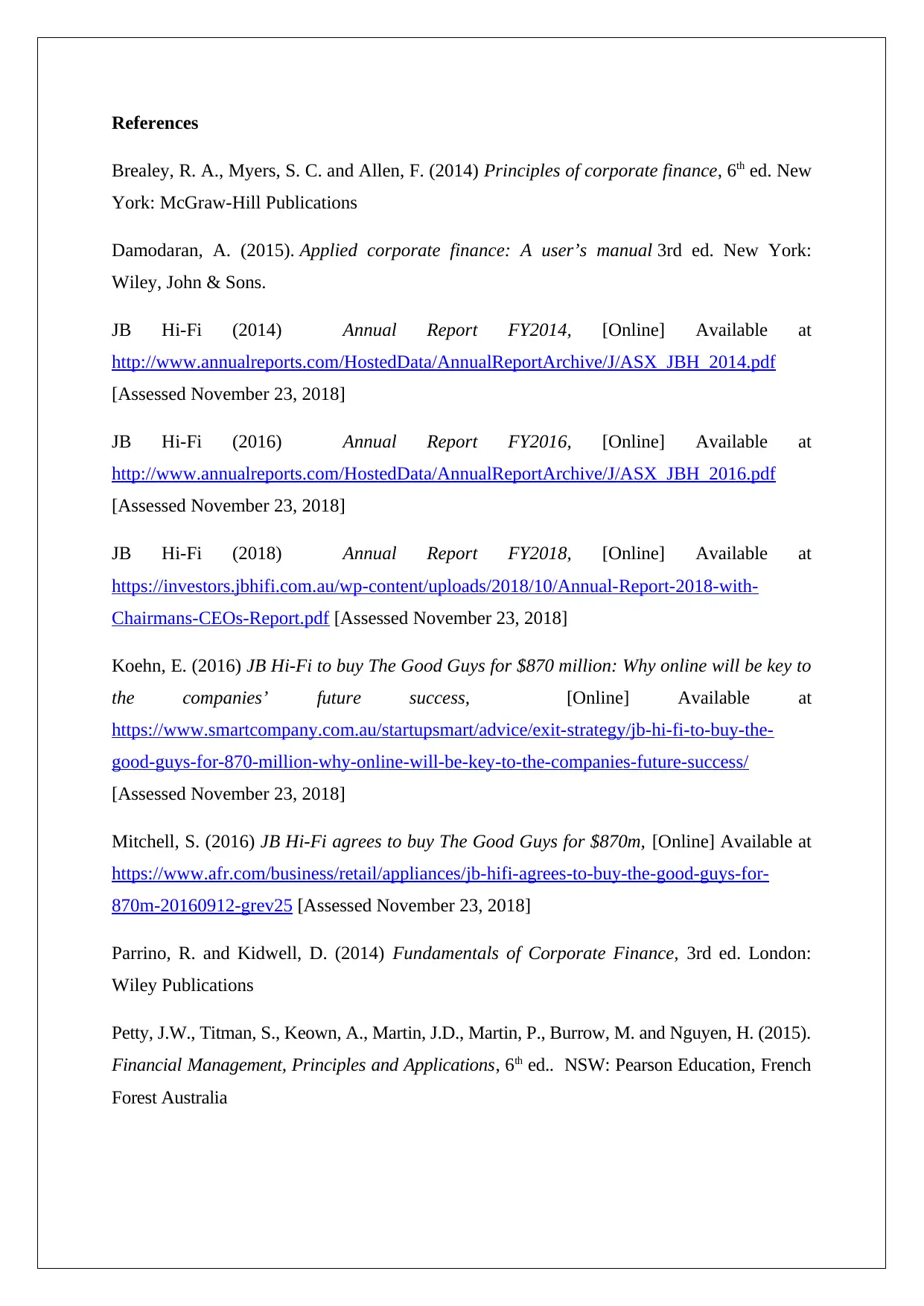
References
Brealey, R. A., Myers, S. C. and Allen, F. (2014) Principles of corporate finance, 6th ed. New
York: McGraw-Hill Publications
Damodaran, A. (2015). Applied corporate finance: A user’s manual 3rd ed. New York:
Wiley, John & Sons.
JB Hi-Fi (2014) Annual Report FY2014, [Online] Available at
http://www.annualreports.com/HostedData/AnnualReportArchive/J/ASX_JBH_2014.pdf
[Assessed November 23, 2018]
JB Hi-Fi (2016) Annual Report FY2016, [Online] Available at
http://www.annualreports.com/HostedData/AnnualReportArchive/J/ASX_JBH_2016.pdf
[Assessed November 23, 2018]
JB Hi-Fi (2018) Annual Report FY2018, [Online] Available at
https://investors.jbhifi.com.au/wp-content/uploads/2018/10/Annual-Report-2018-with-
Chairmans-CEOs-Report.pdf [Assessed November 23, 2018]
Koehn, E. (2016) JB Hi-Fi to buy The Good Guys for $870 million: Why online will be key to
the companies’ future success, [Online] Available at
https://www.smartcompany.com.au/startupsmart/advice/exit-strategy/jb-hi-fi-to-buy-the-
good-guys-for-870-million-why-online-will-be-key-to-the-companies-future-success/
[Assessed November 23, 2018]
Mitchell, S. (2016) JB Hi-Fi agrees to buy The Good Guys for $870m, [Online] Available at
https://www.afr.com/business/retail/appliances/jb-hifi-agrees-to-buy-the-good-guys-for-
870m-20160912-grev25 [Assessed November 23, 2018]
Parrino, R. and Kidwell, D. (2014) Fundamentals of Corporate Finance, 3rd ed. London:
Wiley Publications
Petty, J.W., Titman, S., Keown, A., Martin, J.D., Martin, P., Burrow, M. and Nguyen, H. (2015).
Financial Management, Principles and Applications, 6th ed.. NSW: Pearson Education, French
Forest Australia
Brealey, R. A., Myers, S. C. and Allen, F. (2014) Principles of corporate finance, 6th ed. New
York: McGraw-Hill Publications
Damodaran, A. (2015). Applied corporate finance: A user’s manual 3rd ed. New York:
Wiley, John & Sons.
JB Hi-Fi (2014) Annual Report FY2014, [Online] Available at
http://www.annualreports.com/HostedData/AnnualReportArchive/J/ASX_JBH_2014.pdf
[Assessed November 23, 2018]
JB Hi-Fi (2016) Annual Report FY2016, [Online] Available at
http://www.annualreports.com/HostedData/AnnualReportArchive/J/ASX_JBH_2016.pdf
[Assessed November 23, 2018]
JB Hi-Fi (2018) Annual Report FY2018, [Online] Available at
https://investors.jbhifi.com.au/wp-content/uploads/2018/10/Annual-Report-2018-with-
Chairmans-CEOs-Report.pdf [Assessed November 23, 2018]
Koehn, E. (2016) JB Hi-Fi to buy The Good Guys for $870 million: Why online will be key to
the companies’ future success, [Online] Available at
https://www.smartcompany.com.au/startupsmart/advice/exit-strategy/jb-hi-fi-to-buy-the-
good-guys-for-870-million-why-online-will-be-key-to-the-companies-future-success/
[Assessed November 23, 2018]
Mitchell, S. (2016) JB Hi-Fi agrees to buy The Good Guys for $870m, [Online] Available at
https://www.afr.com/business/retail/appliances/jb-hifi-agrees-to-buy-the-good-guys-for-
870m-20160912-grev25 [Assessed November 23, 2018]
Parrino, R. and Kidwell, D. (2014) Fundamentals of Corporate Finance, 3rd ed. London:
Wiley Publications
Petty, J.W., Titman, S., Keown, A., Martin, J.D., Martin, P., Burrow, M. and Nguyen, H. (2015).
Financial Management, Principles and Applications, 6th ed.. NSW: Pearson Education, French
Forest Australia
1 out of 10
Related Documents
Your All-in-One AI-Powered Toolkit for Academic Success.
+13062052269
info@desklib.com
Available 24*7 on WhatsApp / Email
![[object Object]](/_next/static/media/star-bottom.7253800d.svg)
Unlock your academic potential
Copyright © 2020–2025 A2Z Services. All Rights Reserved. Developed and managed by ZUCOL.



